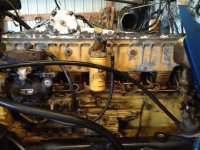If you look at the picture closely you can see a dividing line. Above that is the after cooler and below that is the manifold. The after cooler really isn't that big.
I have yet to figure out the reasoning behind retarding the timing on an 855. It goes against everything I know about diesels and everything I've been taught. By retarding the timing you'll send more unburnt fuel out of the exhaust, so the added fuel does nothing but maybe burn up the turbo. I have a hard time belie sing that retarding the timing so much is easier on the pistons. In advancing the timing, the injection event happens further away from top dead center, when the piston is lower in it's stroke. Retarding the timing causes the injection event to happen closer to top dead center, so the piston will be higher in it's stroke. Therefore, retarding the timing will put the piston closer to the nozzle during the injection event than advancing the timing will. I was always lead to believe, and it makes perfect sense to me, that the closer to the nozzle the piston is during injection, the more heat there will be created in the piston. Leading to melt down. Advancing the timing would cause the injection event to happen when the piston is further away from the nozzle. Keeping heat away from the piston.
I personally believe that the scare came from drivers back in the day being uneducated and maybe driving incorrectly. I will say though what I do with the engine is completely different. I will only have that temperature in the cylinder for 15-20 seconds. Where on the road that temperature will be in the cylinder a lot lot longer.
Maybe I'm completely backwards but that's what I know and my $0.02.
Sent from my iPhone using Tapatalk


